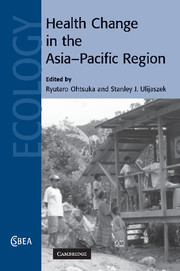Book contents
- Frontmatter
- Contents
- List of contributors
- Acknowledgements
- 1 Health change in the Asia-Pacific region: disparate end-points?
- 2 Interactions of nutrition, genetics and infectious disease in the Pacific: implications for prehistoric migrations
- 3 Biocultural adaptation and population connectedness in the Asia-Pacific region
- 4 Changing nutritional health in South East Asia
- 5 Obesity and nutritional health in Hong Kong Chinese people
- 6 Modernization, nutritional adaptability and health in Papua New Guinea Highlanders and Solomon Islanders
- 7 Tongan obesity: causes and consequences
- 8 Nutrition and health in modernizing Samoans: temporal trends and adaptive perspectives
- 9 Health patterns of Pacific Islanders and Asians in the United States
- 10 Impacts of modernization and transnationalism on nutritional health of Cook Islanders
- 11 Mortality decline in the Pacific: economic development and other explanations
- 12 Health changes in Papua New Guinea: from adaptation to double jeopardy?
- Index
- References
4 - Changing nutritional health in South East Asia
Published online by Cambridge University Press: 15 September 2009
- Frontmatter
- Contents
- List of contributors
- Acknowledgements
- 1 Health change in the Asia-Pacific region: disparate end-points?
- 2 Interactions of nutrition, genetics and infectious disease in the Pacific: implications for prehistoric migrations
- 3 Biocultural adaptation and population connectedness in the Asia-Pacific region
- 4 Changing nutritional health in South East Asia
- 5 Obesity and nutritional health in Hong Kong Chinese people
- 6 Modernization, nutritional adaptability and health in Papua New Guinea Highlanders and Solomon Islanders
- 7 Tongan obesity: causes and consequences
- 8 Nutrition and health in modernizing Samoans: temporal trends and adaptive perspectives
- 9 Health patterns of Pacific Islanders and Asians in the United States
- 10 Impacts of modernization and transnationalism on nutritional health of Cook Islanders
- 11 Mortality decline in the Pacific: economic development and other explanations
- 12 Health changes in Papua New Guinea: from adaptation to double jeopardy?
- Index
- References
Summary
Introduction
Most of the health problems that result from both deficiency and excess of nutrient intake can be found in South East Asia, with those of particular public health significance being protein-energy malnutrition, iodine deficiency disorders, vitamin A deficiency, iron deficiency and the non-communicable diseases (NCDs) for which food intake is an important causal factor. However, the relative importance of each of these has shifted significantly over the last few decades. Social, economic and agricultural developments have brought dramatic achievements in the reduction of poverty and the extent of famine, hunger and starvation in the region, as economies dominated by agricultural production have shifted to those based predominantly on secondary and service industries. These industries have also brought rapid urban growth, dietary and lifestyle changes and demographic ageing of populations, all of which directly or indirectly influence health profiles of nations. But these transitions have not been uniform either across or within countries, and they have features that present significant challenges for governments and agencies in the region.
This chapter focuses on Indonesia, Malaysia, the Philippines, Singapore and Thailand – the five original members of the Association of South East Asian Nations (ASEAN). After describing some of the key features of these countries, I review overall trends in food production, consumption and nutritional health for the region since the 1960s.
- Type
- Chapter
- Information
- Health Change in the Asia-Pacific Region , pp. 64 - 87Publisher: Cambridge University PressPrint publication year: 2007



